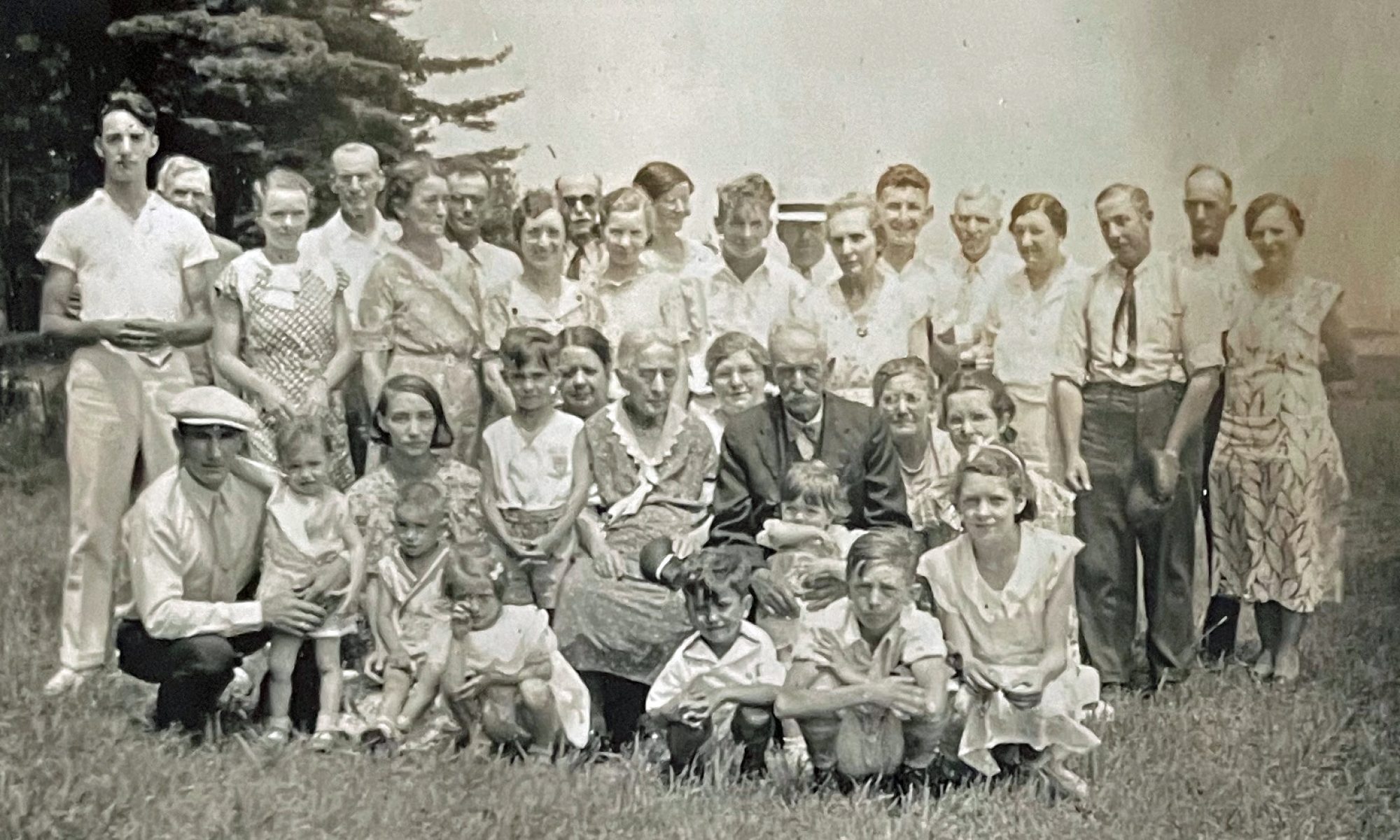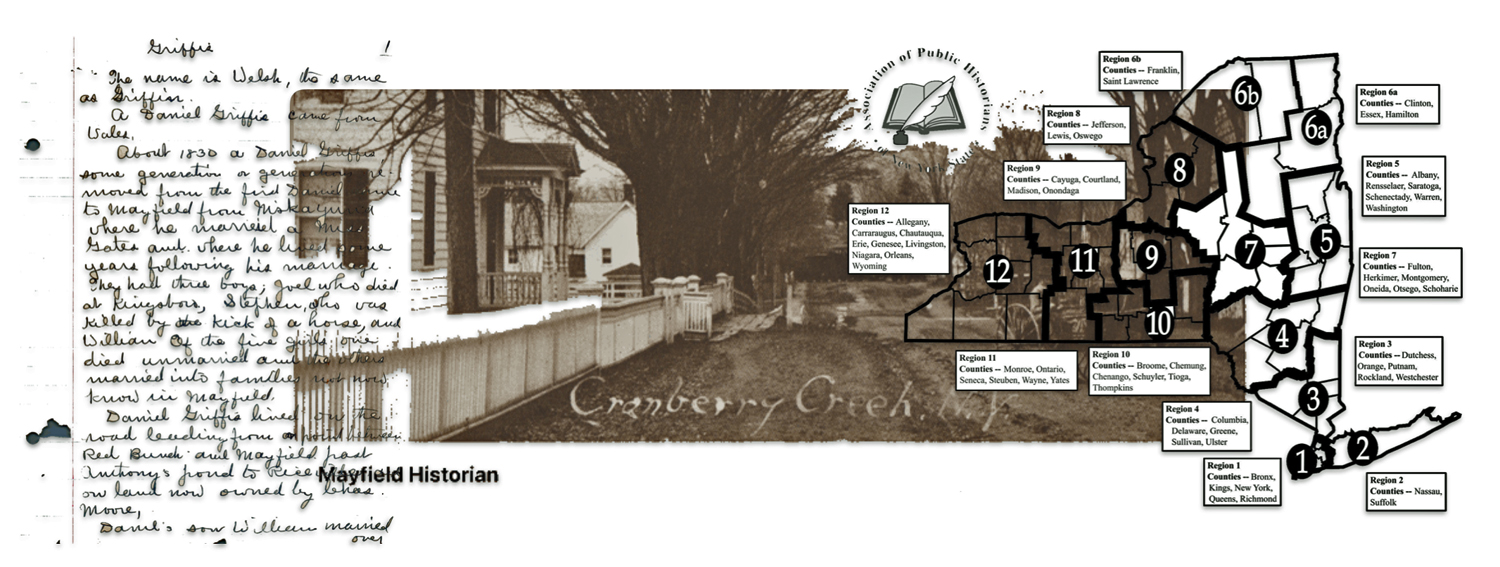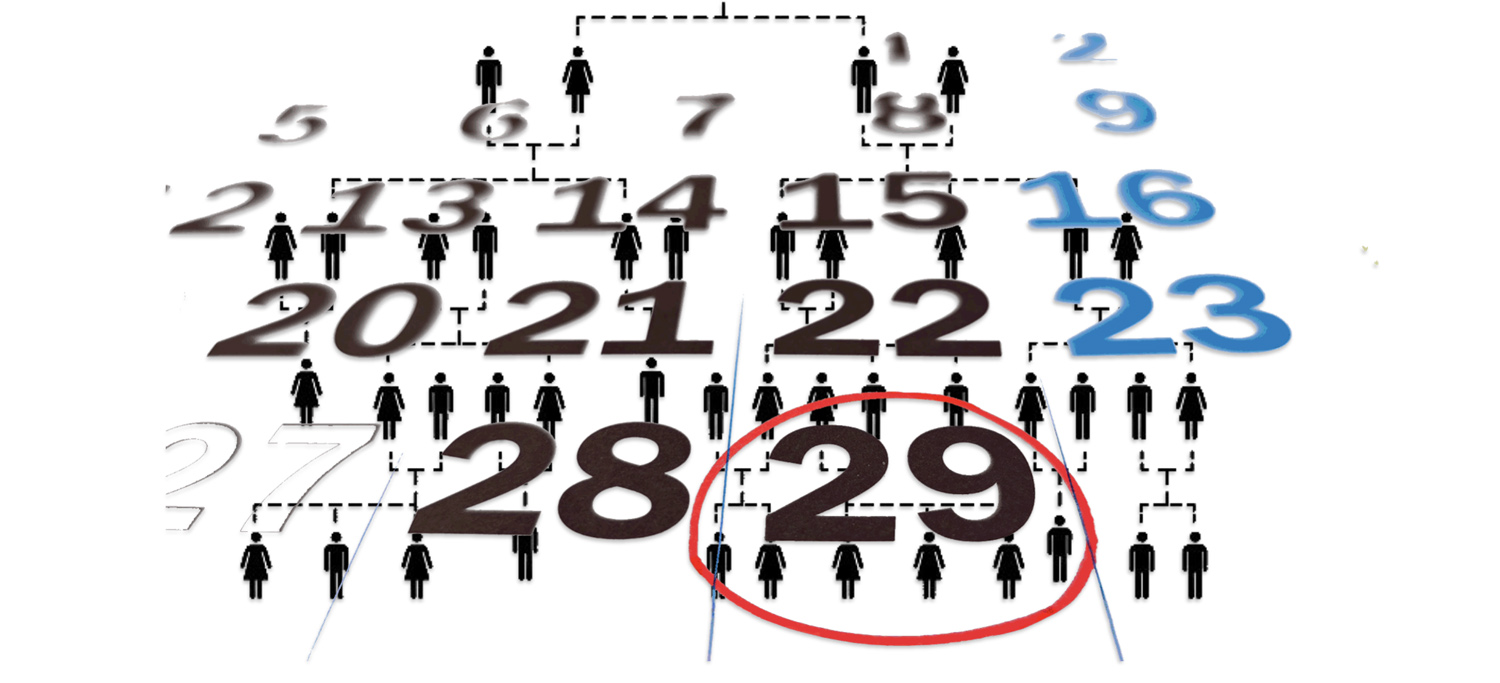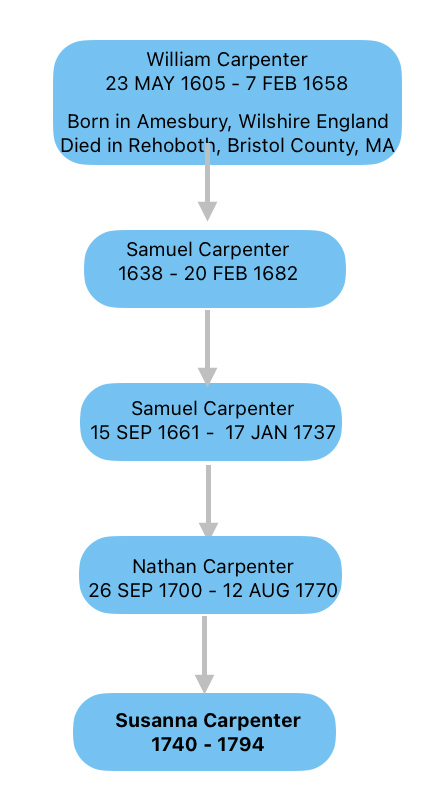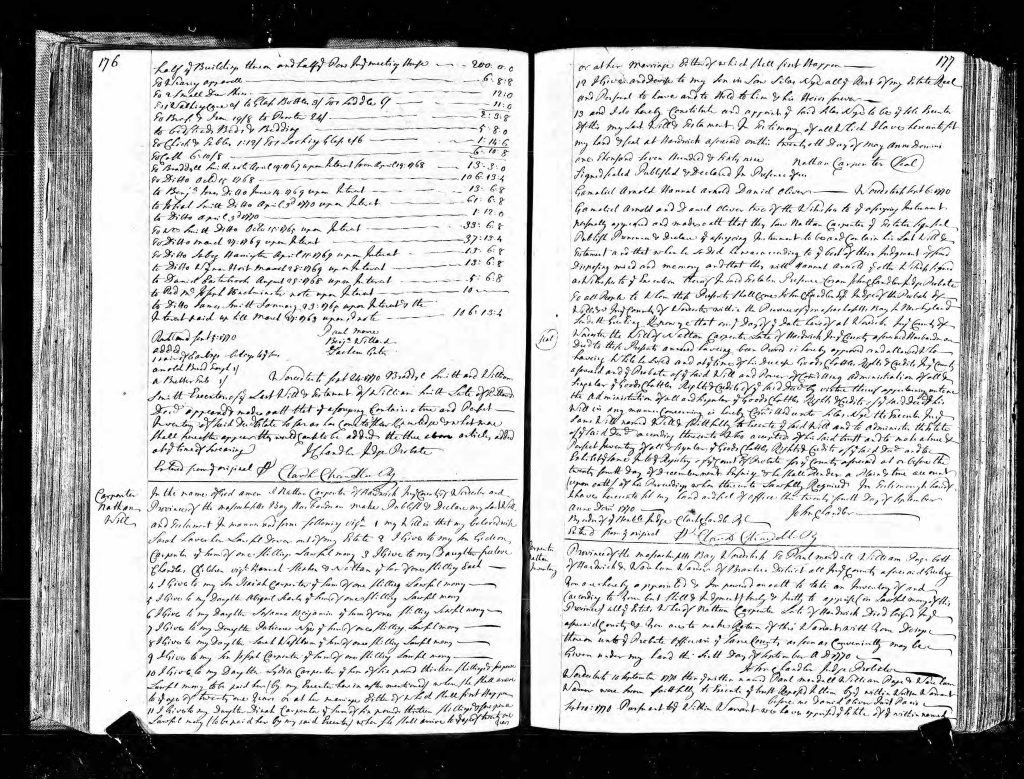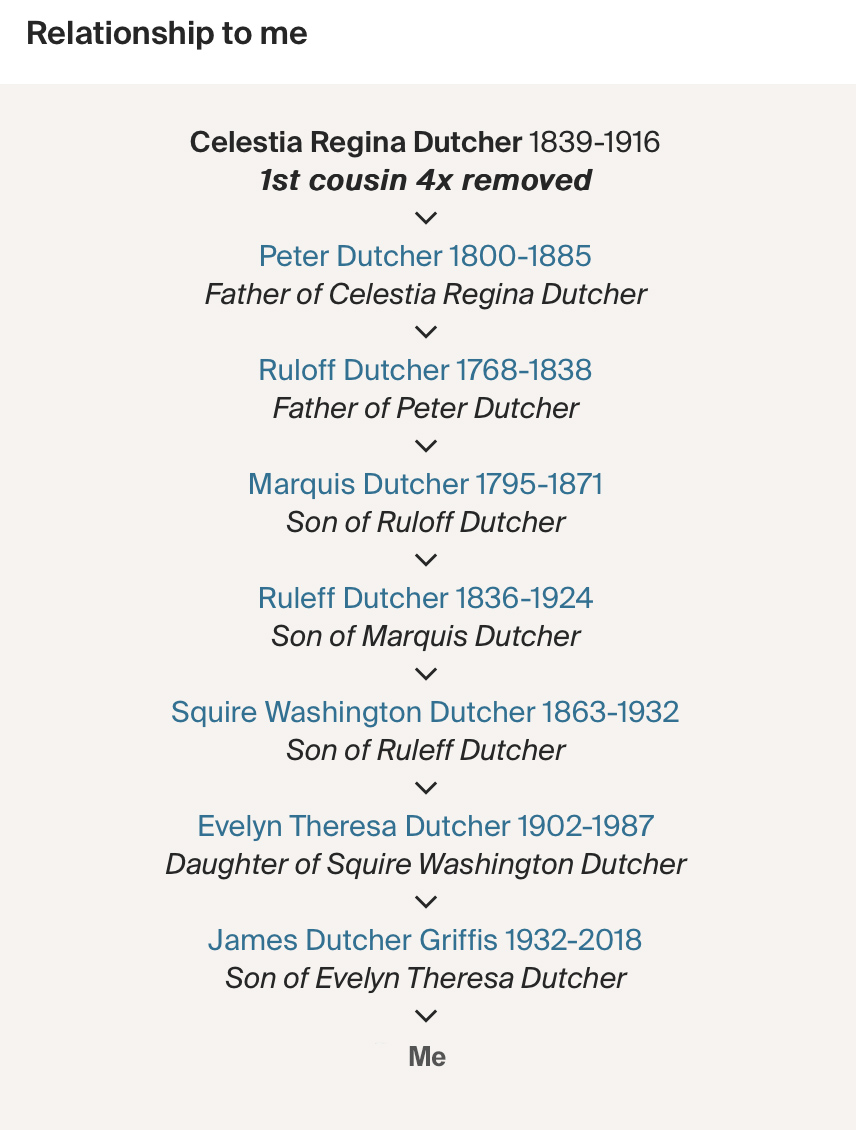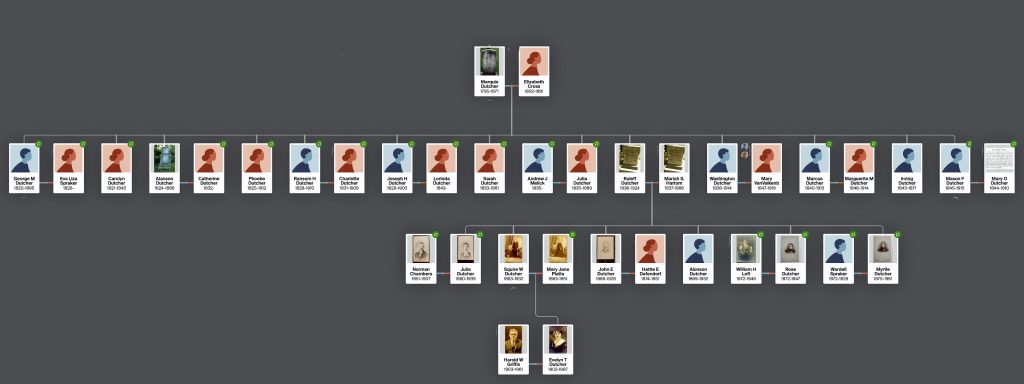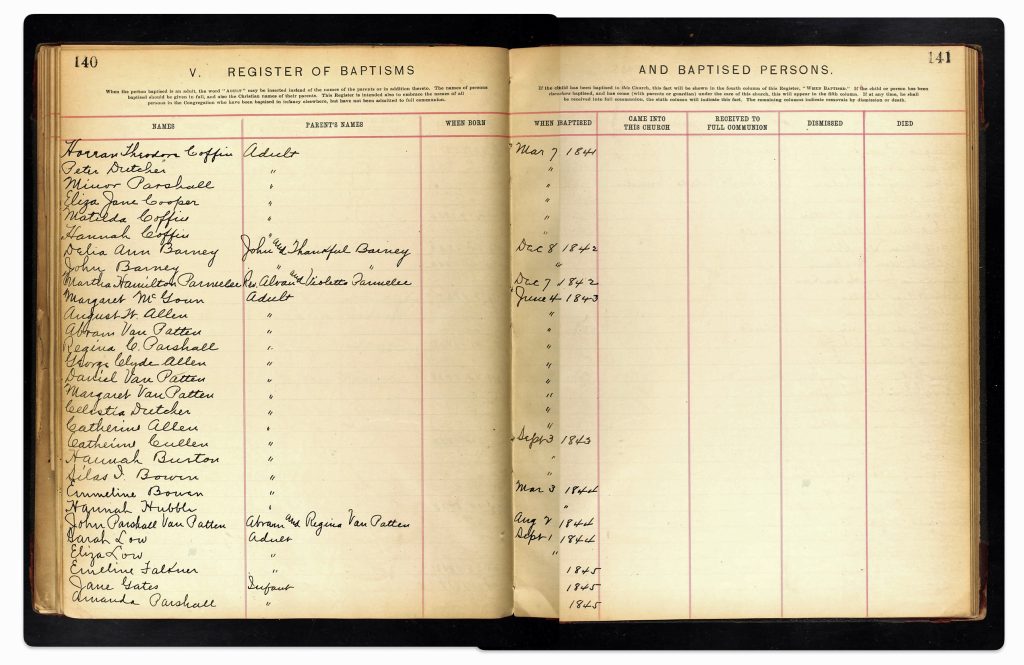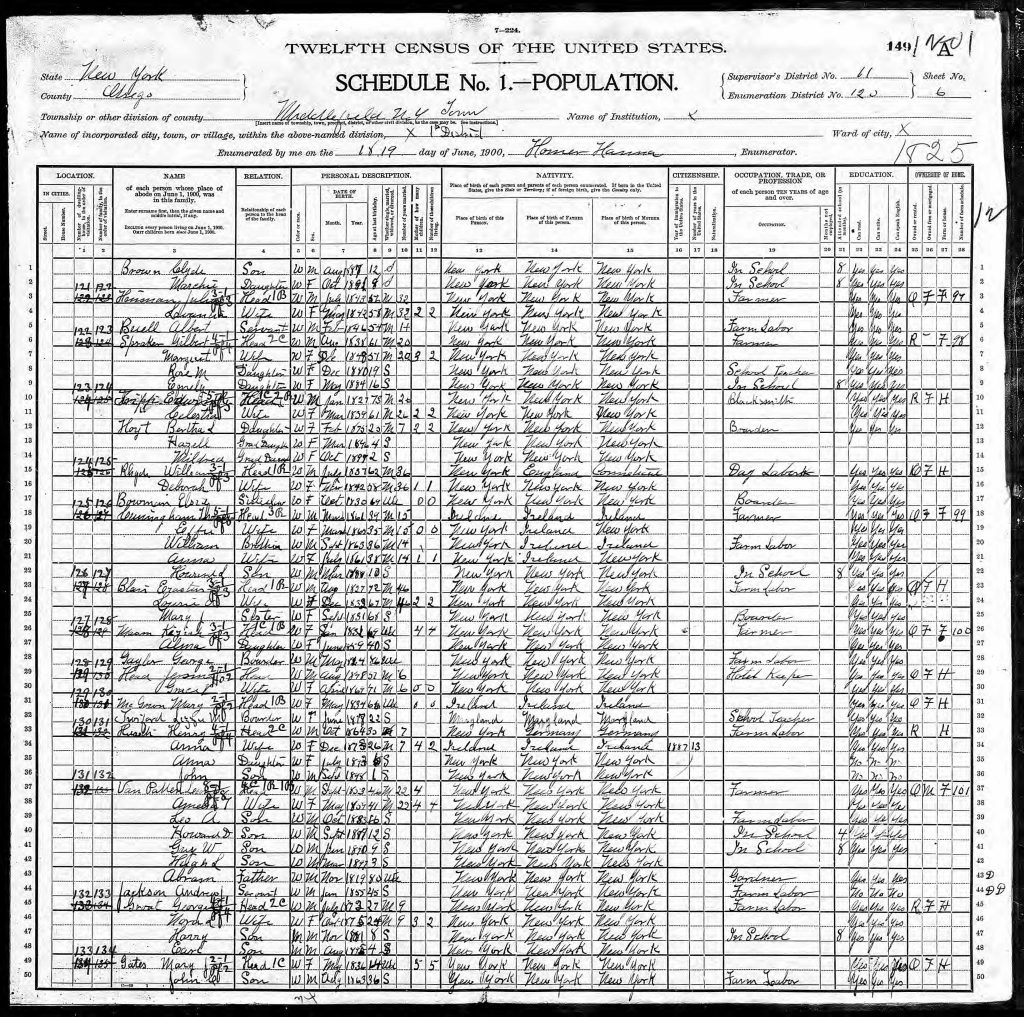Local government historians are vital to their communities. They fulfill many roles to their communities, big or small. They serve as researchers, educators, preservationists, advocates, and coordinators. Their work ensures that the history of a town, city or county is not only preserved but also actively integrated into the community’s present and future, fostering a sense of identity and continuity
The role of a local historian makes every little town or hamlet feel that their stories of the area and its past inhabitants and cherished buildings are important. Individuals who assume these positions also have the wherewithal to ensure that oral and written histories of individuals and families that lived in a specific area are accessible to future generations.
I periodically contact local town historians to see if I can find additional information on various descendants.
I recently obtained copies of handwritten notes and newspaper clippings that were kept by the former Town of Mayfield, New York Historian, the Reverend Edward Ruliffson. Ruliffson’s handwritten notes of oral history are an invaluable resource for my efforts at documenting family genealogy. As noted in prior stories, I have distinguished ‘our’ branch of the Griffis tree that started its existence in colonial America in Huntington, New York as the ‘Mayfield Branch’ of the Griffis tree.
Rev. Edward J Ruliffson and Mary Ruliffson on their Wedding Day in 1897

The Reverend E. Ruliffson (1872 – 1944) held the office of Mayfield Historian in the 1930s and the early 1940s. [1] He compiled and had access to much of the oral history of individuals who lived in Mayfield, New York at the time.
The Rev. Rulliffson had compiled notes on the Griffis and Weatherbee families, both are an integral part or branches of the Griffis family tree that once resided in Mayfield, New York. The notes he had taken have affirmed the results of my research, provided clues to historic hunches that I have as well as unearthed new evidence that will lead me to additional avenues for research.
I will provide another story on what his notes reveal.
At the time of the writing of this story, Mayfield, New York is fortunate to have a young town historian, Eric Close, who recently assumed the duties and role of town historian. This position is not his full time job. Eric is a farmer in the Mayfield area.
While his farm duties consume much of his time, he has effectively invigorated the role of town historian by making local historic records available to the public. He is breathing life into old photographs, newspaper clippings and oral history. Through his enthusiasm and the love of his role as town historian, he is also getting folks excited about their local history in the small rural town of Mayfield.
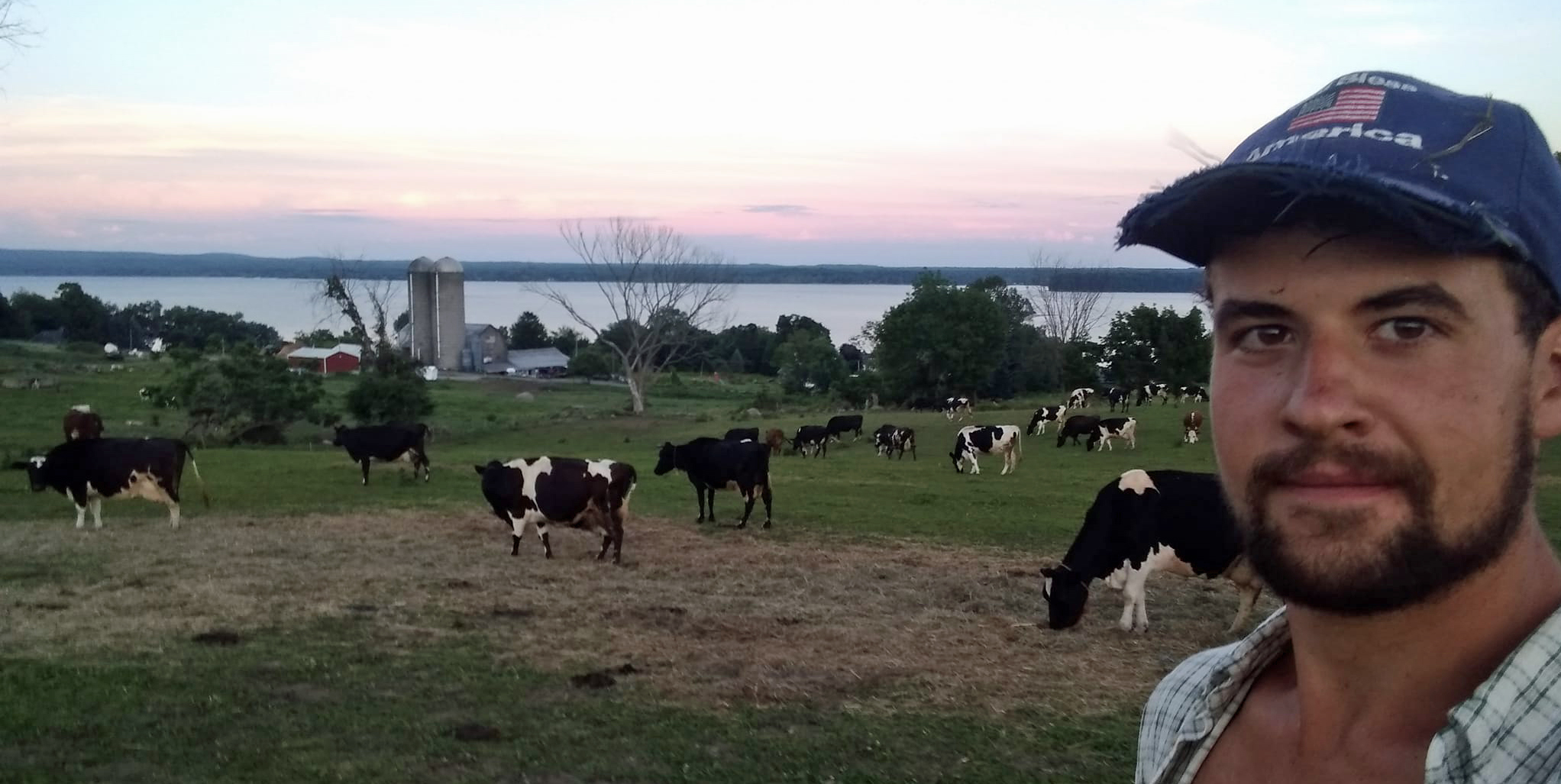
As one avenue to communicate with the public, Eric has assumed the management of a Facebook page for Mayfield New York. Based on correspondence with Eric on this Facebook page, I discovered that the historian’s office of Mayfield had information about the Griffis Mayfield family and the Wetherbee branch of the family. [2] This led me to Rev. Ruliffson’s past efforts as the local historian. Eric quickly sent copies of notes and newspaper clippings related to the two family branches to me.
I hope to visit Eric and his cows in the future and review any additional information he might have on my descendants in Mayfield as well as the history of Mayfield. As an historian, I like his style.
Establishment and Support of Local New York Public Historians
Town historians play a crucial role in preserving, interpreting, and promoting the history of their communities. Their responsibilities are multifaceted and vital to maintaining a community’s historical identity and heritage. They assume a wide range of roles.
The history of local historians in New York is deeply intertwined with the state’s legislative and cultural history, reflecting a longstanding commitment to preserving and interpreting local heritage. This commitment is evident in the establishment of the role of municipal historians – an unique feature mandated by New York State law since 1919.
The Arts and Cultural Affairs Law § 57.07, requires every municipality (encompassing towns, villages, cities) and counties to appoint a public historian to document, preserve, interpret, and share the history of their communities. [3] This initiative, the first of its kind in the United States, underscores New York’s pioneering role in promoting public history at the local level.
100 Years Of New York’s Local Government Historians Law | A New York Minute In History – WAMC July 8 2019
This podcast is one of many “A New York Minute In History” podcasts. [4]
A New York Minute In History is a podcast series about the history of New York and the unique tales of New Yorkers. It is hosted by Devin Lander, the New York State Historian, and Lauren Roberts. Jesse King is the producer.

“One hundred years ago, on April 11, 1919, New York Governor Al Smith signed the “Historians Law.” The first law of its kind in the United States, the Historians Law allowed for every village, town, and city in the state to have an official historian to gather and preserve historical records.“
“On this episode of A New York Minute In History, host and New York State Historian Devin Lander is joined by Clifton Park Historian John Scherer, Saratoga County Historian Lauren Roberts, and former Broome County Historian and past president of the Association of Public Historians of New York State Gerald Smith to discuss the role of local historians and the integral part they play in their communities.”
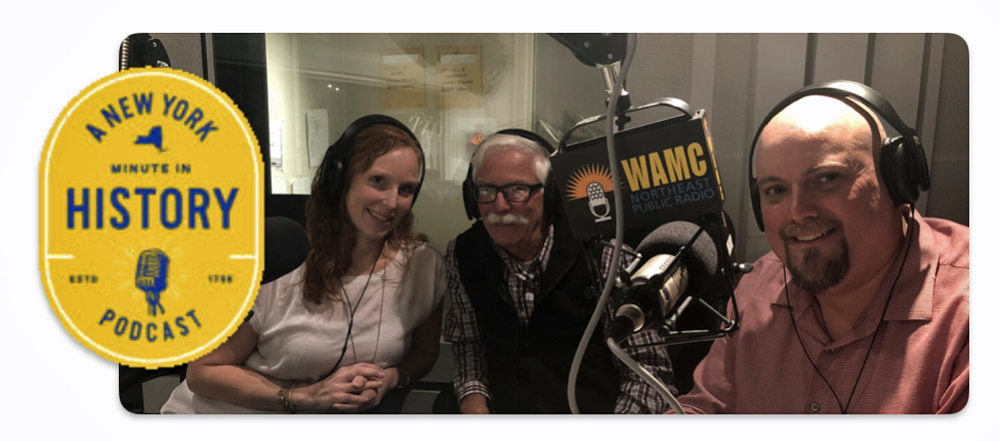
The Association of Public Historians of New York State (APHNYS) plays a crucial role in supporting these government-appointed historians. The association is independent of the public historians but has emerged on the basis of the need for these positions to have a base for support. As a professional organization, APHNYS represents over 1,600 local historians, providing them with a platform for collaboration, sharing best practices, and professional development (see map one). [5] The association’s efforts are aimed at enhancing the quality of historical education and ensuring that New Yorkers have access to rich cultural heritage resources.
Map One: The Association of Public Historians of New York State (APHNYS) Regional Map for Supporting Local Public Historians
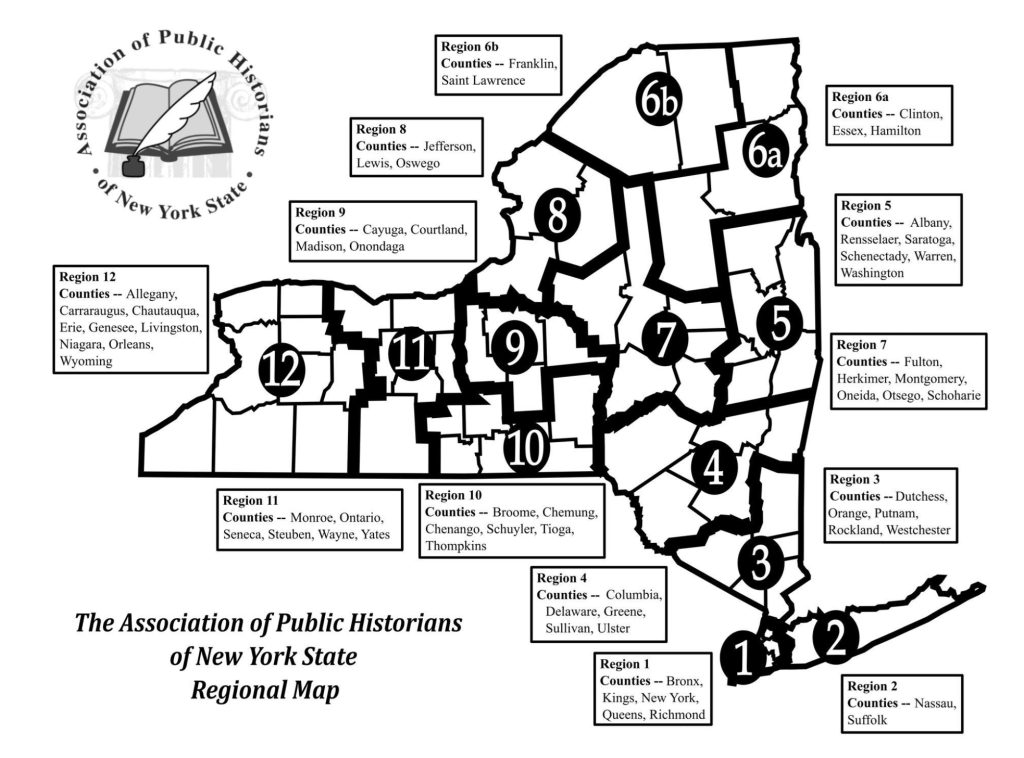
The work of the Local New York Government Historian falls into four broad categories: research and writing, teaching and public presentations, historic preservation and organization, advocacy, and promotion. [6] These duties are rather broad. The local personal handprint of the local historian is based on one’s personal capabilities, personal interest and inclination as well as reflect the priorities and interests of the historian’s local community and appointing authority. [7]
“An Eclectic Bunch” with Varying Levels of Support
To assume the duties of a local New York historian is a labor of love. These roles and duties encompass a wide range of activities and capabilities. Perhaps the underlying core of common traits or abilities of a local historian are the love of local history, the desire to promote historic information and documentation to the community and the desire to assist people who have an interest in the local history of a given village, town, city or county.
The New York state system of public historians works in spite of their organizational limitations and challenges. New York has an impressive array of appointed historical caretakers who, by and large, function independently and without much in the way of guidance and mostly without necessary resources.
The number and composition of the New York local historians changes yearly as does the number of cities, villages and towns, municipalities in New York. [8] One current estimate is the state has 1,641 historians at various levels of government. [9]
Table One: Distribution of Local Public Historians by Level of Government in 2024
| Municipal Level | Number of Entities | Number of Historians | % of Historians |
|---|---|---|---|
| State | 1 | 1 | 100% |
| County | 62 | 57 | 92% |
| City | 62 | 61 | 98% |
| Village | 533 | 567 | 94% |
| Town | 933 | 938 | 99% |
| Borough | 5 | 5 | 100% |
| Community (Manhatten) | 53 | 12 | 23% |
As table one reflects, despite the large number of allotted roles, there is a very low vacancy rate among the available public historian positions in New York State.
“The folks in these roles are an eclectic bunch, to say the least – the oldest town historian to serve was 103, the youngest is 13 – drawn to the gig by that crucial mix of obsession, pride, and boosterism.” [10]
The 1919 Public Historian Law of New York stipulates a broad based requirement for all cities, towns, village and counties. It also provides a wide latitude on the level of support for the role of historian. In the first paragraph, the law stipulates that:
“A local historian shall be appointed, as provided in this section, for each city, town or village, except that in a city of over one million inhabitants a local historian shall be appointed for each borough therein instead of for the city at large; and a county historian may be appointed for each county.” [11]
- The law further stipulates that an “historian shall serve without compensation, unless the governing board of the city, town, village or county for or in which he or she was appointed or in the city of New York, the mayor, shall otherwise provide.”
- The law also stipulates that the New York government entity “may provide the historian with sufficient space in a safe, vault or other fire proof structure for the preservation of historical materials collected.” The governmental entities may also “contract with the trustees of an historical association for the support of any or all historic edifices situated within the boundaries.”
As is the case with all well intentioned laws, there can be unintended consequences or challenges that emerge when attempting to fulfill the obligations of state law and regulations. Based on survey of New York State county and borough historians in 2017, some of the public historians perceive that the position is undervalued, underfunded and underestimated. [12]
Those appointed to be county or borough historians have created their activities to fit their own skills, mostly operating without a clear job description, and with minimal and sometimes no resources or even expectations on the part of appointing officials. Most municipal historians do not receive much or any training. In some municipalities one person is both Historian and the Records Management Clerk. In others, one person fills the positions of Town Clerk and Historian. Many of the public historians lack an official budget, office facilities, or other means of support to fulfill their duties.
The number of historians throughout the state and their respective geographical range of responsibilities to specific municipalities adds a level of complexity when coordinating between neighboring historians as well as the public seeking information and assistance from local historians. This large group of local historians operates more like independent contractors with little contact with each other, or leadership. I imagine there is, by necessity, some coordination among county historians and their municipal and village historians within their respective counties. At the same time, there is an inherent advantage of having historians responsible for specific municipalities. This increases the likelihood that they can be responsive to the local communities’ needs and capable of answering specific historical questions.
Public Historians in Fulton County
Seeking historical information in specific areas for genealogical purposes can be challenging. This can be illustrated in my research on the Griffis family and related branches of the family that lived in Fulton county in the 1800s and 1900s. Fulton County was created on April 18, 1838, by a partition of Montgomery County which resides below Fulton county. To the east is Saratoga county. On the western side of Fulton is Herkimer county. On the north side is Hamilton county. While most of the family members can be traces to Fulton county, there are a few in each of these adjacent counties as well as Otsego county.
While some of the Griffis family lived in Mayfield, New York, many others lived in nearby contiguous areas of Fulton county – such as the cities of Johnstown and Gloversville, the towns of Broadalbin, Ephrata, Johnstown, the villages of Broadalbin Mayfield and Northville and the Hamlet of Kingsboro.
Map Two: Public Historians in Fulton County, New York [13]
As reflected in map two, if I wish to seek assistance from New York public historians to research possible evidence on various descendants who lived in Fulton county, I would need to contact a number of historians for various local areas that are near to each other. To add some confusion to the mix, some of the towns also have villages that also have separate public historians. [14]
The Role of Historian in Mayfield New York
Mayfield village [15] in Fulton County, New York, located in the center of the town of Mayfield [16] northeast of Gloversville. As of the 2010 census, the village population was 832. The population of the town, which includes the village, was 6,495 at the 2010 census. The land that is now the town was part of the Mayfield Patent of 1770. The town was established in 1793.
While the law mandates the creation of the position in each town, village, city and county, it is left to the municipalities to consider payment or monetary support for the position.
The Mayfield Historian is fortunate to receive a modicum of support. As reflected in table two, the Mayfield historian is budgeted $3,625 in 2024 which is roughly 6.5 percent of the total recreation and culture budget of the town. While the historian might be limited in monetary means, Eric adds enthusiasm and energy to come up with ideas that get the community excited about their history.
Table Two: Town of Mayfield, 2024 Adopted Budget: Recreation and Culture [17]
| Category | Actual 2022 Expenses | Budgeted 2023 Expenses | Preliminary & Adopted 2024 Expenses |
|---|---|---|---|
| Personal Services | 1,836.00 | 1,900.00 | 2,000.00 |
| Equipment | – – | 500.00 | 500.00 |
| Contractual Expense | 1,571.25 | 1,300.00 | 1,125.00 |
| Total Historian Budget | 3,407.25 | 3,700.00 | 3,625.00 (6.5%) |
| Total Rec. (Lake Mgmt) & Culture | 56,125.00 |
“Even if these programs don’t pay off with tourism dollars, the effort highlights why New York’s program is still smart, despite its uneven delivery. In a state where most of the money, power, and clout is clustered around New York City, a local historian makes every little town or hamlet feel that their stories and cherished buildings are important, too.”
“Without historians, there’s stuff that falls by the wayside… . There’s no one to document the comings and goings. When a building gets torn down, no one to document it.” [18]
Sources
Feature Banner: The banner is an amalgam, from left to right, of: (1) a copy of one of the hand written pages of oral history compiled by Mayfield Historian Ruliffson on the Griffis Family, (2) the banner photograph on the Facebook Mayfield Historian Page (as of March 1, 2024), and (3) the organizational structure of the Association of Public Historians of New York State, an organization that supports the appointed local public historians.
[1] The photograph to the left is of Rev Edward J. Ruliffson and his wife, Mary taken on their wedding day in 1897 at the Methodist Church, date unknown, Town of Mayfield Website, https://townmayfield.digitaltowpath.org:10052/content/History/Home/:field=images;/content/Images/View/11541
Evidence of J Rulliffson’s work as a local historian is mentioned in 1937:
“J. Ruliffson, town historian of Mayfield, N.Y., reports that he has located the graves of two cousins of Pres. Martin Van Buren—Francis Van Buren, born in 1728, and Maj. Herman Van Buren, born in 1736. These graves were marked on September 27, 1936, with a bronze tablet. The town of Mayfield has cleaned up two of its old burying grounds.”
“NOTES AND COMMENTS.” New York History, vol. 18, No. 1, 1937, pp. 112. JSTOR, http://www.jstor.org/stable/23134577
[2] One of the Griffis men, William J. Griffis, married a Wetherbee, Charlotte L. Wetherbee, and eventually assumed the farm land of her father, Thomas Wetherbee. I digress, long story short, this farm land became three contiguous farms of related families and the road on which the farms resided became known as Griffis Road in Mayfield. This will be a separate story!
[3] Arts and Cultural Affairs Law, Section 57.07, Local Government Historian Law § 57.07. Local historian; appointment; maintenance of historical edifices, Records Management, New York State Archives, Accessed on March 11, 2024, https://www.archives.nysed.gov/records/laws-local-government-historian-law-5707
Association of Public Historians of New York State (APHNYS) Records, 1967-2007, New York State Library, Updated: March 9, 2022, https://www.nysl.nysed.gov/msscfa/sc23302.htm
Carol Kammen, On the State of the State’s County Historians, January 16, 2018, New York State Museum, https://www.nysm.nysed.gov/research-collections/state-history/notes/state-states-county-historians
[4] David Lander, Lauren Roberts, and Don Wildman, 100 Years of New York’s Local Government Historian’s Law, July 8, 2019, WAMCA New York Minute In History, WAMC, July 8, 2019, https://wamcpodcasts.org/podcast/100-years-of-new-yorks-local-government-historians-law/
WAMC-FM (90.3 FM) is a non-commercial educational radio station licensed to Albany, New York, United States, featuring a public radio format. WAMC, Wikipedia, This page was last edited on 8 February 2024 , https://en.wikipedia.org/wiki/WAMC
[5] The Association of Public Historians of New York State, https://www.aphnys.org
[6] Karen Osburn, Why Does New York State Have Municipal Historians?, October 4, 2019, Historic Geneva, https://historicgeneva.org/museum-work/new-york-state-municipal-historians/
See also:
Robert Lowell Goller, Historian’s Corner: NY’s Unique Historian Law Marks 100 years on April 11, March 27, 2019, East Aurora Advertiser, https://www.eastaurorany.com/articles/historians-corner-nys-unique-historian-law-marks-100-years-on-april-11/
Amanda Erickson, New York State’s Curious, Century-Old Law Requiring Every City and Town to Have a Historian Is this still a good idea? , September 12, 2012, Bloomberg, https://www.bloomberg.com/news/articles/2012-09-12/new-york-state-s-curious-century-old-law-requiring-every-city-and-town-to-have-a-historian
David Lander, Lauren Roberts, and Don Wildman, 100 Years of New York’s Local Government Historian’s Law, July 8, 2019, WAMCA New York Minute In History, https://wamcpodcasts.org/podcast/100-years-of-new-yorks-local-government-historians-law/
Editorial Staff, History of the Association of Public Historians of New York State, September 10, 2023, New York Almanack, https://www.newyorkalmanack.com/2023/09/history-of-the-association-of-public-historians-of-new-york-state/
Michael J. Eula, Notion of History and its Importance for a Community, Genesee County Historian, http://cms1files.revize.com/geneseecountynew/docs/History/The_Notion_of_History_and_its_Importance_for_a_Community.pdf
[7] Marvin Livingston, Duties and Functions of the Historian’s Office, Charlton, New York, Page accessed March 11, 2024, https://www.townofcharlton.org/historians-office
A review of the state, county, and local websites that delineate the roles of the historian general touch on the following areas. Not all of these areas are necessarily covered by each historian. A. lot is determined by the capabilities and training of the local historian and the amount of monetary and material support the historian’s office has at their disposal.
Research & Writing: A primary responsibility mentioned by New York State (NYS) town historians is to interpret the past through research and writing. This involves studying various aspects of local history and producing narratives that can be published in books, magazines, newspapers or the internet.
Teaching & Public Presentations: Town historians often engage in teaching and public speaking to disseminate knowledge about local history. They may teach courses in local and regional history, serve as resources to teachers and speak to community groups. They may even participate in radio and TV talk shows to reach a broader audience.
Historic Preservation: Historians advocate for the preservation of historic sites, structures, and materials. They may prepare cultural resource surveys, identify historic structures for nomination to the State and National Register of Historic Places, and develop historic marker programs. Their efforts ensure that significant historical sites and materials are preserved for future generations.
Organization, Advocacy and Promotion: Town historians organize and direct commemorations of historical anniversaries and participate in civic observations. They may act as fundraisers or grant writers for historical programs and support local tourism by promoting the town’s history as an attraction. This role is crucial for heritage tourism, which is a growing segment of the tourism industry.
Reference & Information Services: Providing reference services for the community is another role of town historians. They respond to historical inquiries from residents, visitors, media, and others, ensuring that the historical society or office is a trusted source of accurate information. This requires dedication and competence on the part of the historian.
Collection & Preservation of Materials: Town historians are responsible for collecting, preserving, and making available materials related to the history of the community. This includes current records, photographs, military records, local history books, and more, ensuring that these materials are accessible for research and education.
Liaison and Coordination: They serve as liaisons among the town’s museums, libraries, and historical associations, encouraging historical coordination and collaboration. This role facilitates a unified approach to preserving and promoting local history.
See also:
Role of the Municipal Historian, Schenectady New York, https://www.cityofschenectady.com/565/Role-of-the-Municipal-Historian
Find a Historian, Regional Map, The Association of Public Historians of New York State, https://www.aphnys.org/Find-A-Historian
Chris Leonard, Blog of the Schenectady City Historian, Blog, https://www.historianchris.com/blog
Greene County New York, New York State Historians, https://www.nygreene.com/uploads/1/2/5/2/125254448/nys-historians-law-roles-and-responsibilities.pdf
Town Historian Information Packet, Livingston County Historian’s Office , New York, October 2023, https://www.livingstoncounty.us/DocumentCenter/View/17406/New-Historian-Packet?bidId=
William Ketzer, Historian of Bethlehem Historian, https://www.townofbethlehem.org/151/Town-Historian
[8] List of Municipalities in New York, Wikipedia, This page was last edited on 9 March 2024, https://en.wikipedia.org/wiki/List_of_municipalities_in_New_York
List of towns in New York, Wikipedia, This page was last edited on 9 March 2024, https://en.wikipedia.org/wiki/List_of_towns_in_New_York
Boroughs of New York City, Wikipedia, This page was last edited on 12 March 2024, https://en.wikipedia.org/wiki/Boroughs_of_New_York_City
List of Manhattan neighborhoods, Wikipedia, This page was last edited on 27 January 2024, https://en.wikipedia.org/wiki/List_of_Manhattan_neighborhoods
[9] Greene County New York, New York State Historians, https://www.nygreene.com/uploads/1/2/5/2/125254448/nys-historians-law-roles-and-responsibilities.pdf
[10] Amanda Erickson, New York State’s Curious, Century-Old Law Requiring Every City and Town to Have a Historian Is this still a good idea? , September 12, 2012, Bloomberg, https://www.bloomberg.com/news/articles/2012-09-12/new-york-state-s-curious-century-old-law-requiring-every-city-and-town-to-have-a-historian
[11] Arts and Cultural Affairs Law, Section 57.07, Local Government Historian Law § 57.07. Local historian; appointment; maintenance of historical edifices, Records Management, New York State Archives, Accessed on March 11, 2024, https://www.archives.nysed.gov/records/laws-local-government-historian-law-5707
[12] Carol Kammen, On the State of the State’s County Historians, January 16, 2018, New York State Museum, https://www.nysm.nysed.gov/research-collections/state-history/notes/state-states-county-historians
[13] Fulton County, Google Maps, https://www.google.com/maps/place/fulton+county+new+york/data=!4m2!3m1!1s0x89de57892d26f873:0xdc562c066c8dab13?sa=X&ved=1t:242&ictx=111
Fulton County, New York, Wikipedia, This page was last edited on 6 October 2023, https://en.wikipedia.org/wiki/Fulton_County,_New_York
Association of Public Historians of New York State (APHNYS), Fulton County Historians, https://docs.google.com/spreadsheets/d/e/2PACX-1vRaP3ScMgOfOXlJFnUoV3AvLZ_hZHJDcdx6FaPAiDtrCkuUGXqSMSIn1bbifWLuNaj6EFdDVFNFYWIG/pubhtml#
[14] The relationship between towns and villages in New York State is defined by their legal incorporation, the services they provide, and the way they are governed. Villages offer a more localized layer of governance and services within the broader jurisdiction and service provision of towns. Residents of villages engage with and benefit from both levels of local government, contributing to the complex administrative landscape of New York State.
Towns are larger entities that encompass all non-city areas and provide a broad array of services, governed by a town board. Villages, on the other hand, are smaller, incorporated municipalities within towns that provide more localized services, governed by a board of trustees including a mayor.
Villages are governed by a board of trustees, which includes a mayor and trustees. The mayor serves as the chief executive officer, responsible for enforcing village laws and overseeing the village’s employees. Some villages may also have a village manager who handles administrative duties.
Villages in New York State have less autonomy than cities but are able to provide municipal services and have their own form of local government, typically a board of trustees including a mayor. Despite this autonomy, villages are not independent of the towns in which they reside; they are subject to the town’s jurisdiction to a certain extent.
Both towns and villages provide services to their residents, but the scope and nature of these services can vary. Towns cover larger areas and can encompass multiple villages, offering services like road maintenance, public safety, and administrative functions for the broader area. Villages, being smaller, tend to focus on services at a more localized level, such as garbage collection, street maintenance, and local zoning.
- Geographic Overlap: A village is always part of a town, but the reverse is not true; not all parts of a town are within a village. This means that some residents live in “town-outside-village” areas, receiving services directly from the town without the additional layer of village governance.
- Functional Overlap: While towns and villages may both provide similar types of services (e.g., public safety, road maintenance), the presence of a village within a town allows for more localized control and potentially more tailored services to meet the specific needs of the village residents
Town Government & Village Government, The Local Government Handbook. New York State, https://video.dos.ny.gov/lg/handbook/html/village_government.html
Administrative divisions of New York (state), Wikipedia, This page was last edited on 17 February 2024, https://en.wikipedia.org/wiki/Administrative_divisions_of_New_York_%28state%29
[15] Mayfield (village), New York, Wikipedia, This page was last edited on 27 July 2023, https://en.wikipedia.org/wiki/Mayfield_(village),_New_York
Administrative divisions of New York (state), Wikipedia, This page was last edited on 17 February 2024, https://en.wikipedia.org/wiki/Administrative_divisions_of_New_York_(state)#Village
[16] Mayfield, New York, Wikipedia, This page was last edited on 7 January 2024, https://en.wikipedia.org/wiki/Mayfield,_New_York
[17] Town of Mayfield, 2024 Adopted Budget, Schedule A1, General A Fund Appropriations, Recreation and Culture, Page 6, https://townmayfield.digitaltowpath.org:10052/content/Generic/View/11:field=documents;/content/Documents/File/1366.pdf
[18] Amanda Erickson, New York State’s Curious, Century-Old Law Requiring Every City and Town to Have a Historian Is this still a good idea? , September 12, 2012, Bloomberg, https://www.bloomberg.com/news/articles/2012-09-12/new-york-state-s-curious-century-old-law-requiring-every-city-and-town-to-have-a-historian
